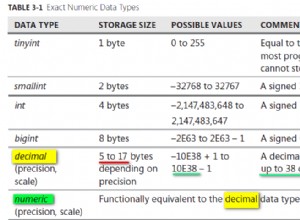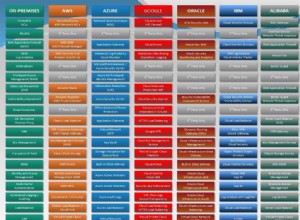Uma associação muitos para muitos com valores adicionais não é uma muitos para muitos, mas sim uma nova entidade, pois agora tem um identificador (as duas relações com as entidades conectadas) e valores.
Essa também é a razão pela qual as associações muitos-para-muitos são tão raras:você tende a armazenar propriedades adicionais nelas, como
sorting , amount , etc O que você provavelmente precisa é algo como seguir (eu fiz ambas as relações bidirecionais, considere fazer pelo menos uma delas unidirecional):
Produtos:
namespace Entity;
use Doctrine\ORM\Mapping as ORM;
/** @ORM\Table(name="product") @ORM\Entity() */
class Product
{
/** @ORM\Id() @ORM\Column(type="integer") */
protected $id;
/** ORM\Column(name="product_name", type="string", length=50, nullable=false) */
protected $name;
/** @ORM\OneToMany(targetEntity="Entity\Stock", mappedBy="product") */
protected $stockProducts;
}
Armazenar:
namespace Entity;
use Doctrine\ORM\Mapping as ORM;
/** @ORM\Table(name="store") @ORM\Entity() */
class Store
{
/** @ORM\Id() @ORM\Column(type="integer") */
protected $id;
/** ORM\Column(name="store_name", type="string", length=50, nullable=false) */
protected $name;
/** @ORM\OneToMany(targetEntity="Entity\Stock", mappedBy="store") */
protected $stockProducts;
}
Estoque:
namespace Entity;
use Doctrine\ORM\Mapping as ORM;
/** @ORM\Table(name="stock") @ORM\Entity() */
class Stock
{
/** ORM\Column(type="integer") */
protected $amount;
/**
* @ORM\Id()
* @ORM\ManyToOne(targetEntity="Entity\Store", inversedBy="stockProducts")
* @ORM\JoinColumn(name="store_id", referencedColumnName="id", nullable=false)
*/
protected $store;
/**
* @ORM\Id()
* @ORM\ManyToOne(targetEntity="Entity\Product", inversedBy="stockProducts")
* @ORM\JoinColumn(name="product_id", referencedColumnName="id", nullable=false)
*/
protected $product;
}




